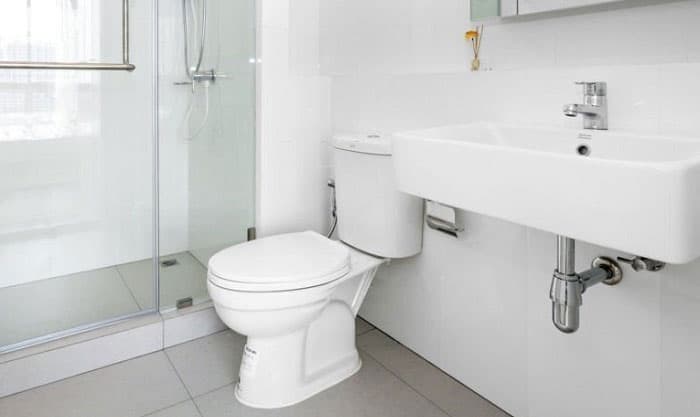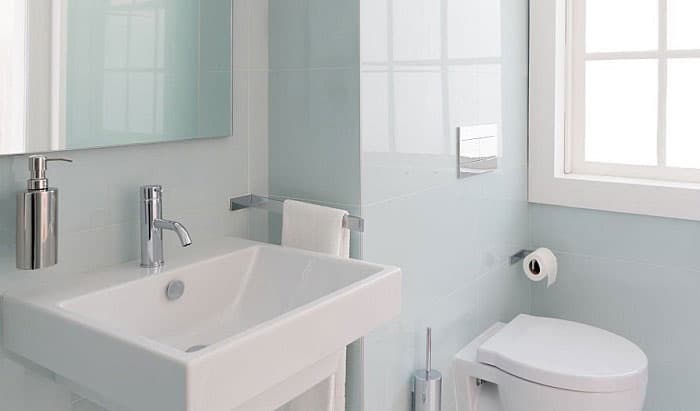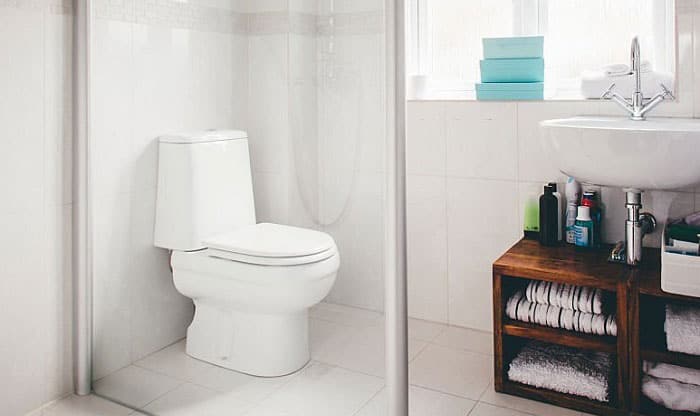Water closets and lavatories are in the same context. But the various terminologies confuse people. For instance, it’s referred to as ‘toilet’ in English-speaking countries and ‘restroom’ in the USA. Meanwhile, it’s a ‘comfort room’ in the Philippines. Amid these variations, let’s look at the exact definition of water closet and lavatory.
A water closet is an enclosed toilet with running water and a plumbing system for flushing urine and poop. Lavatory came from the Latin word ‘lavatorium’ that means ‘I wash’. Hence, it denotes the water used when washing hands, shaving, and washing hands.
In the past, ‘lavatory’ was the common term for urinal rooms used by monks. However, ‘lavatory’ is viewed by some people in America as impolite and improper. Some prefer to use the toilet for this thing. If you still need further clarification, read on to know the difference between water closet vs lavatory.
Table of Contents
Water Closet – All You Need to Know
1. History
In the past, a bathroom was located inside the house but there was an outhouse where waste disposal occurs. The design of the water closet in plumbing is taken from this system. It started among wealthy families and hotels in 1870.
The knowledge that waste caused diseases obliged homeowners to have their water closets inside their houses. This enlightenment took place in 1890 but people in the UK still practice the separation of toilet and bathroom. At the beginning of the 20th century, America started to merge toilets and bathrooms as one. This action overlooks privacy, which is the reason why some buyers still value water closets.
2. Defining Water Closet
A water closet is simply a flush toilet in a room. It’s a complete package of a toilet unit (a toilet bowl and parts for the water system). People patronize it because of optimal sanitation and hygiene.
The main parts are the toilet bowl, tank, and toilet seat. Furthermore, the usual height of a toilet bowl is 16 inches from the floor. The water used for flushing is contained in a tank. Various materials are used for toilet seats but the most affordable and durable is ceramic.
These parts can be bought as a set but they’re also sold separately. Some people buy separate parts for replacement. Normally, the whole unit is needed for a new installation.
3. The Different Types of Water Closet
- One-piece
The bowl and tank of this water closet are attached so it’s together in one piece. It’s a space saver as it’s low and close to the floor. Apart from its sleek appearance, this type of toilet is easy to clean. You can also rely on its durability. The downside is the difficulty of shipment because of its weight.
- Two-piece
The two-piece toilet is very common in the United States. It’s the opposite of the one-piece since the toilet and tank are not connected. Thus, you need to do some extra work to attach them. Expect that installation requires more effort and time. Nonetheless, the elderly can benefit from its tall seat. You can save money because it’s affordable too.
Although it’s more challenging to clean than the one-piece units, replacement on damaged parts is possible. The best examples are Toto Drake, Toto Entrada, and Kohler Highline Comfort.
- Wall-hung
Just what its name implies, this type of toilet is hung on the wall. It’s another space saver toilet because the tank is hidden. The exposed parts are a bowl and flush buttons or plate. It’s easy to clean and suitable for elderly and disabled individuals as the seat is adjustable.
This toilet is usually near a water source and installation is done by a professional. The best ones in the market are Swiss Madison Forever Ivy and Kohler Kingston.
- Smart water
This modern innovation is also called an intelligent water closet with several amazing features. Some of them are hands-free flush, night light, heated seats, and dryer with warm air. This toilet consumes less water and takes less space.
Due to hands-free flushing, it’s more hygienic than other toilets. However, it costs more and increases your electric bill. Maintenance has an additional fee and repairs should be attended by a professional.
4. Tips on How to Maintain a Water Closet
Cleaning a toilet is a struggle but it must be done. Depending on the usage frequency, it should be done twice or more every week. Here are some tips:
- Every user should flush after use.
- Avoid using bleach on water closets because it contains corrosive substances, such as chlorine and acid. It can destroy your toilet’s surface and harm your health when sniffed.
- It’s recommended not to flush hard or solid objects in the toilet. If you do so, you’ll only encourage clogging issues, which make cleaning tedious.
- Always make sure the trash can is available near the toilet.
More Information About Lavatory
The word ‘lavatory’ is derived from a Greek word that means ‘I wash’. To track down its origin, it is defined as a ‘washroom’ or ‘a place to wash’. Time flies and its meaning changes into the restroom found in planes and schools. A lavatory is also referred to as a bathroom where you can wash your hands at a sink or basin.
The sink has a bowl and a faucet while the basin controls the water flow with levers. The water gets into the bowl when you’re washing hands and brushing your teeth. You’ll find bowls in different materials like ceramic, glass, and wood. Moreover, the bowl includes the overflow trap and drain.
The drain is a holeunder the bowl. With a stopper, you can fill in the bowl with water. When water spills over, the tiny hole called the overflow trap allows the water to escape. Hence, flooding in the bathroom is prevented.
1. The Different Types of Lavatory
- Wall-mount
This type of lavatory is mounted on the wall, which carries its weight. It doesn’t contact the floor so it saves you some space. Hence, it’s just right for small bathrooms. You have all the liberty to install it at the height you desire. You can also cover the pipes connected to this lavatory. However, you need to hire a professional to install it for you.
- Bowl or vessel
The other term for this lavatory is ‘countertop sink’. It’s aesthetically appealing and made in various materials, such as glass, stone, and marble. Additionally, it has a round sink over the countertop so you won’t have a hard time washing your face. Also, the installation is straightforward.
You should be aware that the lever can get stuck since it’s fragile. Since it sits on the countertop, it can occupy a lot of space too.
- Under-mount
This one is installed below the bathroom countertop. Its best feature is the ease of cleaning. You’ll also save some space but a stand-alone sink can’t be installed since it’s not on the countertop.
- Drop-in or self-rimming
Also known as the ‘top-mount’ sink, it has a rim that covers the vessel for weight support. Apart from easy installation, the possibility of fitting most counters will please you. But due to its link to the countertop, it takes a lot of space.
- Pedestal
It’s a large basin that has a narrow base. This option is a space saver so it’s ideal for small bathrooms. The weight involved in its structure is held by the pillar. Although it’s a stand-alone sink, there’s no room for storage.
- Console
You may think that a console lavatory is also a wall-mounted type but it’s more of a semi-pedestal one. It’s supported by ceramic or metal legs. This lavatory can save floor space. Though it doesn’t have a countertop, you’ll find it with small shelves or a towel rack.
- Trough
It’s longer and deeper than the drop-in lavatory. Because of its width, this usually has two faucets. It’s found in bathrooms occupied by two people. You can customize this lavatory based on your preference and you may also turn it into other types of lavatories: a vessel, drop-in, under-mount, or wall-mount.
- Corner
You can have it on a pedestal or wall-mounted. It can be added to a bathroom with limited space. You may even place it in the bathroom’s corner. Since it’s small, you can save some floor space. However, it won’t be stable on flat surfaces.
2. Some Tips in Maintaining a Lavatory
Toothpaste, shaving cream, and hair can clog a lavatory in the plumbing system. It’s best to prevent issues from arising so you won’t need to hire a plumber. Keep your lavatory clean and observe the following things:
- To unblock the clogs in your lavatory, put a tablespoon of salt into the drain then a cup of vinegar. Let them sit for an hour. After that, pour hot water to get rid of the substances that caused clogging.
- You can occasionally pour bleach or hot water on your lavatory for blockage prevention.
Knowing the Difference Between Water Closet and Lavatory
In this part, the lavatory vs water closet is discussed in two points.
1. Term usage
The water closet is recognized for plumbing fixtures and installation within a room that is built for comfort and relief when responding to the call of nature. This room is called a water closet or toilet as time passes by. On the other hand, a lavatory is a mere substitute for a toilet. However, some find it inappropriate to use. Nowadays, the lavatory is used to call the toilet in a plane or washroom.
2. Functions
A water closet has a tank filled with water for flushing down waste. In the case of a lavatory, there’s a faucet to supply the water that goes into the bowl. The disposal of waste is also different. A water closet flushes down excretion while a lavatory discards the water used for washing hands and brushing teeth.
https://youtu.be/QDDHVLxR_GA
Takeaway
After you’ve read this whole article, the differences between the water closet vs lavatory should be clear to you. A water closet is another term for a toilet and it takes care of solid and liquid waste. You would wash your hands and brush your teeth in the lavatory, so it’s a bathroom sink. Now, you can use these terms appropriately.

I’m Paulk Webb, and I work as a writer for Saveourwaterrebates. I’m happy to put in the time and effort to conduct market research to identify the most pressing issues faced by households concerning their plumbing. Feel free to check out our guides to get the most informed recommendations for how to solve your problems.




